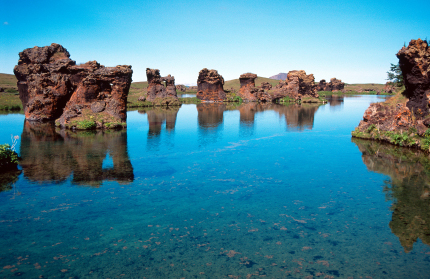Vinna við nýjar heimasíður Umhverfis- og orkustofnunar og Náttúruverndarstofnunar er í gangi. Heimasíða Umhverfisstofnunar er virk á meðan vinnunni stendur. Information in English
About Mývatn

Lake Mývatn and the river Laxá region are protected according to laws no. 97 from the 9th of June, 2004. The objective of the law is to promote nature conservation according to the principles of sustainable development and to ensure that the ecological limits of the region will not be endangered.
The law is to ensure the protection of the biological diversity of the large water tegion of Mývatn and Laxá and to protect the geological formations and landscape with active nature conservation, especially from a scientific, sociological and aesthetic standpoint. The laws pertain to a 200-metre-wide stretch of banks along lakes, rivers and springs and the following wetland regions: Sortulækur, Geirastaðahraun, Sandvatn (ytra), Belgjarskógur, Slýja, Neslandatangi, Framengi, Kráká from Strengjabrekka to Laxá, Grænavatn, Helluvaðsá and Arnarvatn. The law also protects the water catchment area of Mývatn and Laxá.
Details regarding necessary protective acts, further protection of natural artefacts, exploitation of land, and public access will be put forth in a management plan for the entire district. Mývatn lake and Laxá river are listed as internationally important wetlands according to the Ramsar Convention. The Icelandic Environmental Agency is responsible for the surveillance of the area and ensures that its ecology is not disturbed.
Wardens operate in Mývatnssveit district and provide tourists with assistance and information. Tourists are asked to treat this sensitive area with care and avoid interrupting its wildlife. Other nature conservation areas in the district are Skútustaðagígar craters, Herðubreiðarfriðland and Askja.
Mývatn lake is about 37 square kilometers in area incised by numerous inlets and creeks, and dotted with around 50 islands and islets. The average depth is 2.5 meters, and maximum natural depth only around 4 meters. Mývatn's ecosystem is unique. The name of the lake derives from the myriad of midges in the area. Bird life is varied, and more species of duck are said to live there than in any other place on Earth. Mývatn district is varied in nature and its landscape unique, being formed by intense volcanic activity.
The Nature conservation division of the Environmental Agency publishes information brochures in English,German (old version) and French (old version) about Mývatn and Laxá.
Evironmental Issues
The main environmental issues in Mývatns district are related to energy production and the soil erosion. Plans in the seventies for large-scale power plants in the Laxá river led to the legal protection of the area. A nature research centre was established in the aftermath. The geothermal power plant Krafla has a noticeable impact on the landscape. There is some cinder mining in the area, especially in Jarðbaðshólar hills. A great deal of erosion has occurred east of Mývatn lake, and the vegetation and landscape of Dimmuborgir was severely threatened for some time. The causes of the erosion are most likely related to an interplay between grazing, atmospheric changes and volcanic activity in Vatnajökull glacier. Soil cultivation is underway to put an end to the erosion.